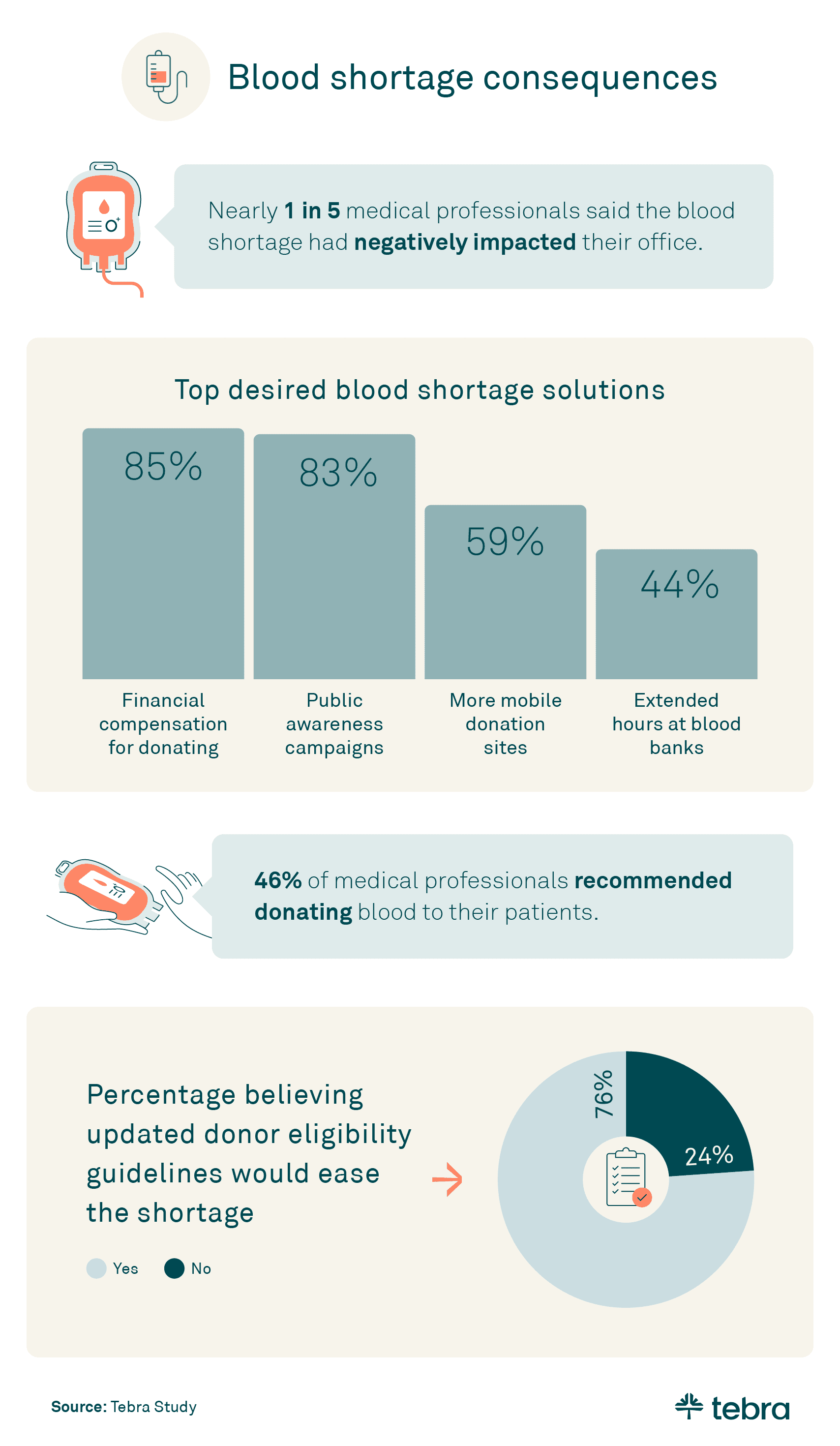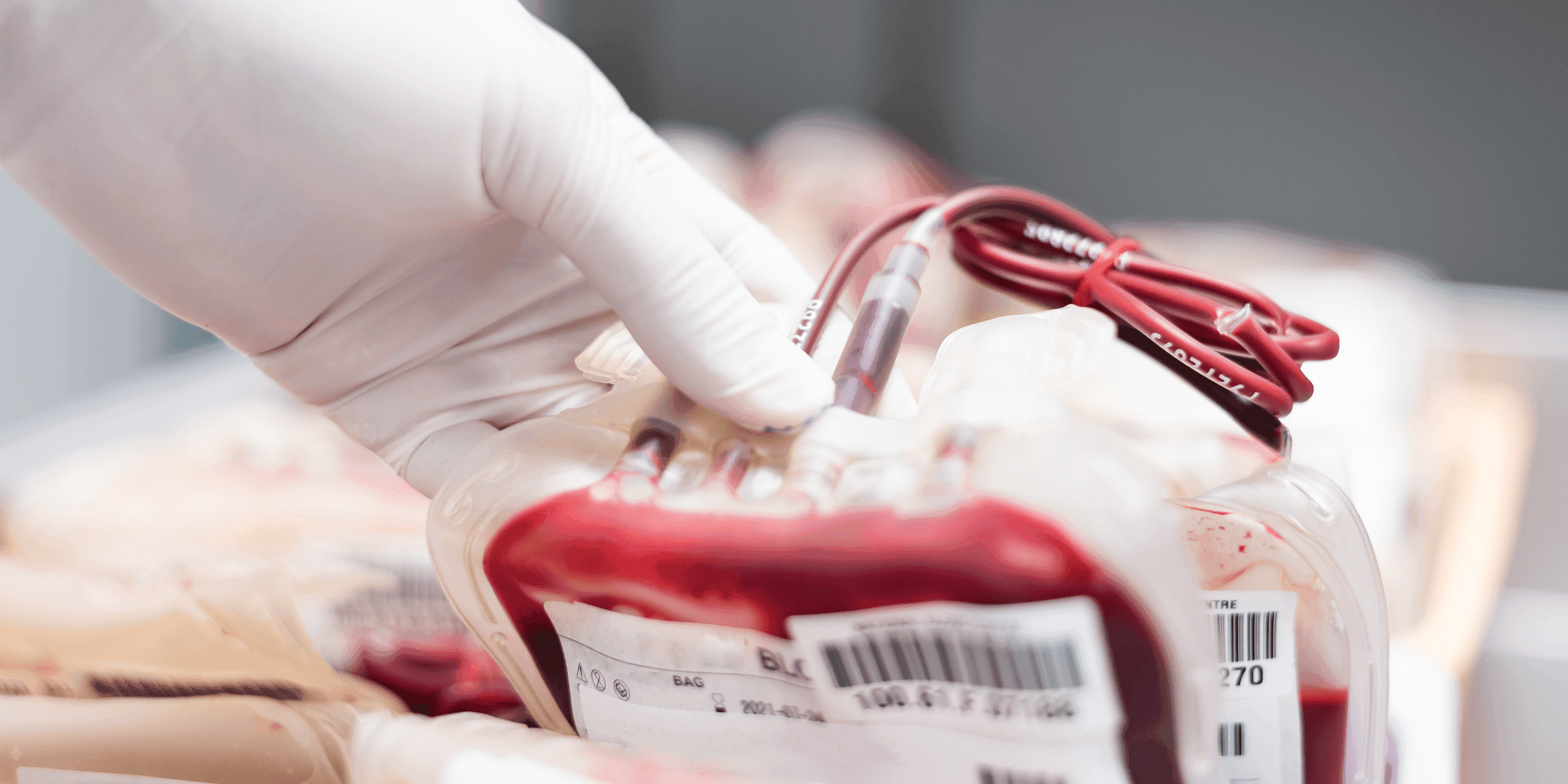Blood is a vital resource that’s become scarce in our healthcare system. But not all hope is lost if people are willing to learn more about it and donate.
Tebra surveyed medical professionals to better understand the problems facing the nation due to the shortage. We also asked how professionals to weigh on on how to best to end the shortage. Lastly, we gathered information about blood donation centers around the country.
Read on to find out about the 2024 blood donation shortage and how you can help.
Key takeaways
- Nearly 1 in 5 medical professionals say the blood shortage has negatively impacted their office.
- 85% of medical professionals support financial compensation to help end the blood shortage.
- Nebraska has the most blood donation centers per 1 million residents.
Status of the blood shortage
On January 7, 2024, the Red Cross declared an emergency blood shortage as the number of donors dropped to a 20-year low. The Red Cross has cited various factors contributing to the falling number of donations. One factor cited is the rise of remote work that has decreased turnout at mobile blood drives, and more recently, an influx of winter weather has also stifled donations.
Analyzing the blood shortage
First, we asked medical professionals about their experiences and perceptions of the blood shortage.
The shortage consequences and donation solutions

Nearly 1 in 5 medical practitioners (18%) said the national blood shortage had negatively impacted their office. Without an adequate amount of blood, medical professionals are limited in their abilities. The most common impacts they reported from the shortage were reduced frequencies of blood transfusions, limited emergency response capabilities, and the delay of surgeries.
When asked how the problem could be fixed, the top answer was financial compensation for those who donated blood (85% agreed this would help reduce the shortage). Close behind, 83% also believed a public awareness campaign was essential to ending the shortage. Many medical professionals (86%) believed the public was insufficiently informed about the national blood shortage, which an awareness campaign could certainly help fix. More mobile donation sites and extended hours at blood banks were seen as helpful but not as crucial.
Almost half of medical professionals (46%) have recommended that their patients donate blood. Meanwhile, 1 in 3 had donated blood themselves in the past year. But hopefully, as the pool of eligible donors expands, so will the amount of available blood. Recent rule changes now allow people to donate blood regardless of their gender or sexual orientation, and 3 in 4 medical practitioners believed this change would help reduce the shortage.
Where you can help
Increased blood donations is the best way to impact the 2024 shortage. Independent Practitioners can encourage patients to donate blood, as well as disseminate information about local donation centers. You can find Red Cross blood donation centers near your practice here.
The states with the most donation centers per 1 million residents are:
- Nebraska
- New Hampshire
- Vermont
- Maine
- Connecticut
- Montana
- West Virginia
- Idaho
- Oregon
- Georgia
Unfortunately, easy access to blood donations is not available in some U.S. states.
The 11 states with no Red Cross blood donation centers are:
- Alaska
- Arkansas
- Florida
- Hawaii
- Louisiana
- Nevada
- New Mexico
- North Dakota
- Rhode Island
- South Dakota
- Wyoming
How to donate blood
Here are some common procedures that are typical when considering blood donation. Use this information to prepare your patients on what to expect and where to begin.
Eligibility check: Review the basic eligibility requirements for donating blood, which typically includes being in good health, at least 17 years old (16 with parental consent in some areas), and weighing at least 110 pounds.
Find a blood drive or donation center: Use resources like the American Red Cross or local hospital websites to locate a nearby blood drive or donation center. You can also keep a local list handy in your office for patients.
Appointment: Schedule an appointment. While walk-ins are often welcome, having an appointment helps manage donor flow.
Preparation: Donors should stay hydrated, eat iron-rich foods, and avoid alcoholic beverages before donating. They should bring a photo ID and a list of any medications.
Donation process: The process typically includes registration, a brief health screening, the donation itself (which takes about 8-10 minutes), and a short recovery period with refreshments.
Aftercare: Blood donors are encouraged to drink plenty of fluids, avoid strenuous activities for the rest of the day, and if they feel dizzy or light-headed, sit or lie down until feeling better.
Stopping the shortage
As we conclude our exploration of the critical blood shortage affecting our healthcare system in 2024, it’s clear that the scarcity of this vital resource poses significant challenges. However, there’s a path forward. Our conversations with medical professionals reveal valuable insights into the problem’s severity and profound impact on national health.
These experts have also shared their views on the most effective strategies to alleviate this shortage. Additionally, we’ve compiled information on blood donation centers nationwide to guide those willing to make a life-saving contribution. The solution lies within our community’s willingness to learn about and participate in blood donation.
We can play a crucial role in resolving this crisis and safeguarding our nation’s health by taking action.
Methodology
Tebra surveyed 100 medical professionals about their perceptions and experiences with the national blood shortage. Additionally, we analyzed the Red Cross blood donation centers listing to see which states offered the most and least donation spots per 1 million residents.
About Tebra
Tebra provides digital tools and support for Independent Practices so they may deliver modern care and operate efficiently. To learn more about how Tebra is committed to improving patients’ and providers’ success and well-being, visit www.tebra.com.
Fair use statement
Are you hoping to inspire others to donate blood? Feel free to share this article — we ask that you do so for noncommercial purposes and link back to this page.







